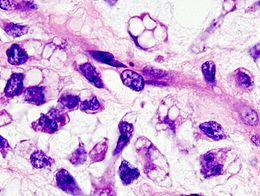While liposarcomas appear in the first instance very similar to lipomas , the masses are usually less mobile, firmer, and hard to manipulate, and may cause pain to your dog as well. Liposarcomas are not particularly common in dogs , and certainty nowhere as near as common as lipomas. He is the author of The Dog Cancer Survival Guide: Full Spectrum Treatments to Optimize Your Dog ’s Life Quality and Longevity.
He is a member of the American Veterinary Medical Association, the Hawaii Veterinary Medical Association, the American Association of Avian Veterinarians, the National Animal Supplement Council and CORE (Comparative Orthopedic Research Evaluation). The wor lipoma , implies a benign tumor, but there is a malignant version of lipoma , a liposarcoma. A liposarcoma is not a lipoma gone ba but a tumor arising from juvenile fat cells. Dogs affected by a liposarcoma can have a good prognosis, but usually need a major surgical procedure to completely remove the tumor. What is liposarcoma in dogs?
Is a lipoma a malignant tumor? Can dogs get liposarcoma? Lipomas refer to benign (noncancerous) tumors of the fat tissue that can be distinguished from the malignant liposarcoma tumors by cytology or biopsy. Liposarcoma is an uncommon type of tumorous cancer that develops in primarily older dogs.

This type of cancer is quite a bit less commonly seen than many other forms. Discovering lumps and bumps on your dog can cause immediate panic. Dog parents always assume the worst-case scenario: cancer. But many lumps are often benign fatty tumors called: dog lipoma. Learn more about dog lipomas from the causes to the key steps you should take for treatment.
Lipoma Vs Liposarcoma Lipoma refers to an adipose tumor or a type of tumor comprising of fatty tissue. These are almost always benign (non-cancerous) and are most frequently found to arise in the subcutaneous tissues although they may also be observed in other deeper tissue regions like the abdominal organs or the intermuscular septa. If your lipoma is enlarging or becomes painful, check with your doctor. A skin biopsy may be required to exclude liposarcoma. In general, liposarcoma is a disease while lipoma is just a disorder.

Other differentiators include the age group in which this is develope the genetic predisposition to the development of the lump, the nature and size of the lump developed and the location and the nature of symptoms associated with the lump development. My dog is really lumpy, now what? They are rare in dogs and cats. Older animals are predisposed. The typical dog with lipomas is a middle-age overweight female.
Think of lipoma development as a semi-normal part of the canine aging process. While lipomas are usually benign, the fatty tumor known as liposarcoma is malignant—an fortunately, also rare. Fatty tumors, called lipomas, are firm, movable growths that develop under a dog’s skin. At times, these tumors become invasive, developing into infiltrative lipomas.

Both types of lipomas are benign, differing from the malignant liposarcoma. A needle biopsy is required to tell the difference between benign and malignant tumors. The description ofthis condition is similar to that ofinfiltrative lipoma ofman and ofthis neoplasm in dogs. Liposarcoma in Dogs Canine liposarcoma is a condition that affects elderly dogs and occurs due to alteration of DNA in dogs as they grow older.
The prognosis of this health issue is poor in case of pets, which is why they are more prone to death due to such a problem in comparison to human beings. There a number of features that can help distinguish between lipoma and well-differentiated liposarcoma. This article relates to superficial well-differentiated liposarcomas that typically occur in the extremities, also known as atypical lipomatous tumors, and not retroperitoneal liposarcoma.
Well-differentiated liposarcoma (atypical lipoma ) of deep soft tissue of the extremities, retroperitoneum, and miscellaneous sites. A follow-up study of cases with analysis of the incidence of “dedifferentiation” Am J Surg Pathol.
No comments:
Post a Comment
Note: only a member of this blog may post a comment.